Measuring ORP in the aeration basin of a wastewater treatment plant
Application Report | Water & Wastewater
- Determination of the oxidation-reduction potential for controlling the intermittent denitrification
- Replacement of an analogue measuring system with digital 2-wire measuring technology including
- Cost reduction and increased operating safety through direct communication between sensor and control system

Background
The Association for Water Supply and Sewage Treatment Geiseltal (ZWAG), in the Saalekreis district of Saxony-Anhalt, Germany, operates a central wastewater treatment plant which receives municipal wastewater from the administrative region. After the mechanical cleaning process, the wastewater flows through two aeration basins into a combined basin with integrated final treatment. During full biological wastewater treatment, the activated sludge process is applied with simultaneous aerobic sludge stabilisation. The micro-organisms in the activated sludge are exposed to a constant "hunger state", so that almost all usable substances are processed as nourishment. Technically, this works through a discontinuous supply of oxygen in the basin – referred to as intermittent denitrification. Nitrification and denitrification are controlled throughout the lifetime of the bacteria in the activated sludge. The activity of the bacteria is therefore significantly dependent on the oxidation-reduction potential (ORP).This redox potential is one of the most important values in order to correctly adjust the aeration and depletion control of the aeration basin.
Measurement requirements
The ZWAG has been using an analogue ORP measurement for some time. The measured voltage from the sensor is converted in the transmitter and transferred as a 4…20 mA signal to the control system. Recently, there have been repeated failures at the measuring point as the transmitter was no longer fully functional, which disturbed the communication between the sensor and the transmitter. The customer was therefore faced with the decision either to invest a multi-figure euro sum into an analogue measuring system from the same manufacturer, or to replace the entire measuring point.
KROHNE Solution
The ZWAG decided on the SMARTPAT ORP 1590. The digital 2-wire ORP sensor communicates directly with the control system through the 4…20 mA/HART® signal, without the need for an additional transmitter. This is already integrated in the sensor head. The measured voltage is converted into the 4…20 mA/HART® signal in the sensor and the sensor communicates directly with the SCADA system.
Although SMARTPAT allows off-line calibration in the laboratory – with direct storage of the calibration data in the sensor – the customer can also calibrate the sensor periodically on-site. Therefore, the sensor must not necessarily be removed from the assembly. Through the use of a suitable junction box (see picture below) the sensor can be accessed directly with a HART FSK modem. Thanks to the free of charge KROHNE DTM software, it is possible to communicate with the sensor on a laptop using an FDT frame application like PACTware™. The sensor remains in the current loop and after cleaning is immersed into the redox solution and calibrated. The calibration data is stored directly in the sensor, which is then reinserted into the basin.
Customer benefits
SMARTPAT ORP 1590 offers the customer significantly higher operating safety. The compact electronics which are built into the sensor reduce the risk of a measuring point failure, largely because an additional transmitter is no longer required. The signal processing on the low-ohm 4…20 mA/HART® is carried out directly in the sensor. With this new sensor concept, the problems experienced with the classical transmitter have been solved.
The ZWAG has benefited particularly from a much cheaper solution with significantly lower costs for acquisition, installation and ongoing maintenance. On the one hand, the cable connection no longer needs to protected by an expensive shield to prevent erroneous transmission of the weak voltage signal to the transmitter. On the other hand, the transmitter no longer has to be replaced every few years.
The standardised sensor design allows installation in virtually all assemblies available on the market. In addition, the SMARTPAT technology enables rapid on-site calibration of the sensor without transmitter. Offline calibration is also an option for the customer in the future. With the help of the appropriate SMARTPAT accessories the lifetime of the sensors can be increased under laboratory conditions through cleaning, regeneration and calibration.






